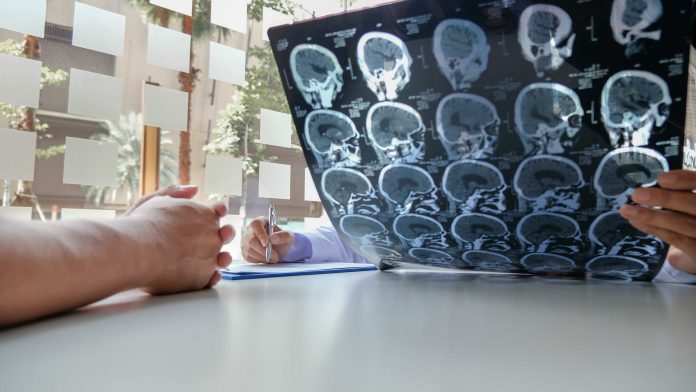Adam Nickerson, Head of Category, Digital and IT procurement frameworks at NHS Shared Business Services (NHS SBS), explains how artificial intelligence software (AI) is used to support decision making & transform outcomes for stroke patients
Artificial intelligence software (AI) is a prime example of how new technologies have the potential to transform NHS patient outcomes, speeding up diagnosis and treatment times by ensuring expert clinical resource is targeted where it has the greatest impact for patient care.
The NHS Long Term Plan has set objectives to improve services and outcomes for stroke patients. These include attaining a ten-fold increase in the proportion of patients who receive a thrombectomy after a stroke by 2022 so that each year, 1,600 more people can live independently after their stroke. It also aims to have the best performance in Europe for delivering thrombolysis to all suitable patients by 2025.
Life-changing treatments for stroke patients
The milestones for stroke care also contain the scaling of technology to drive the expansion of life-changing treatments, including the use of AI interpretation of CT and MRI scans to support clinical decisions regarding suitability for thrombolysis and thrombectomy.
Every year, over 100,000 people in the UK are affected by stroke (source: The Stroke Association). Speed and accuracy in the interpretation of brain scans are critical to diagnosis and treatment. Interventions are time-dependent, with significant harm and long-term disability caused if left untreated.
Ischaemic stroke is the most common stroke. It happens when a blood clot, or other blockage, cuts off the blood supply to the brain. Those diagnosed as being eligible can be treated with a clot-busting drug i.e. thrombolysis. It needs to be administered within four and a half hours of stroke symptoms starting. The more time that passes, the less effective thrombolysis will be. Thrombectomy physically removes a clot from the brain. Like thrombolysis, it has to be carried out within hours of a stroke starting.
AI can speed up the diagnostic process & reduce decision-making time
The use of AI can speed up the diagnostic process, crucial to facilitating timely interventions in stroke. This software uses AI algorithms to support the clinical decision-making process, providing real-time interpretation of imaging to augment the review, diagnosis and delivery of treatments.
AI can reduce the decision-making time for both thrombolysis and thrombectomy, increasing the numbers of patients eligible for both interventions and improving the likely benefit of treatment. The Diagnostics: Recovery and Renewal Report finds it can provide interpretation of imaging within seconds, as opposed to up to 30 minutes when manual review of the images is undertaken remotely by a reporting doctor.
The use of AI software is also an integral part of the National Optimal Stroke Imaging Pathway (NOSIP). Designed to guide the efficient use of radiology resources and reduce duplication, the NOSIP puts a patient’s rapid need of appropriate brain and vessel imaging acquisition and interpretation front and centre of the initial assessment when a stroke is suspected. AI features prominently for use as decision support, rather than as a substitute for expert radiological interpretation.
“Rapid brain imaging is one of the most important steps in stroke patient care”
According to Dr David Hargroves, Getting It Right First Time (GIRFT) Clinical Lead for Stroke and National Specialty Advisor for Stroke Medicine, NHS England and NHS Improvement (NHSEI), “rapid brain imaging and its interpretation is arguably one of the most important steps in the care of patients with stroke-like symptoms. Adherence to the NOSIP, incorporating AI decision support software, is likely to improve access to disability-saving interventions to thousands of patients”.
Novel procurement framework for ischaemic or haemorrhagic stroke images As a mechanism to support providers of hyperacute stroke care in the purchase of AI software, and NHS trusts and networks to deliver the optimal pathway for patients suspected of suffering a stroke, NHS SBS has developed a novel procurement framework, the only one of its kind in the UK, specifically for the analysis of images for the detection of ischaemic or haemorrhagic strokes.
Developed with expert contributions from NHSEI, clinical leads from the 20 Integrated Stroke Delivery Networks across England, the Academic Health Science Network – and with further input from NHSX and the Care Quality Commission – The Provision of AI Software in Neuroscience for Stroke Decision Making Support framework agreement enables NHS organisations to source and acquire this innovative medical technology, and use evidence-based, cost-effective technology to provide rapid treatment where required.
Suppliers to the framework are working right at the cutting edge of healthcare. In an emerging marketplace, contracting with the most innovative technology start- ups can come with challenges. This route helps remove barriers and de-risks procurements, thereby providing a viable commercial solution offering assurance to public sector buyers.
Future progress in outcomes for stroke patients
Darrien Bold, NHSEI National Digital and AI Lead for Stroke, observes that over the past 18 months, the health and care system has been compelled to look to new technologies to continue providing frontline care, with the stroke community embracing new ways of working in times of unprecedented pressure and realising the benefits.
“We are already seeing the impact AI decision-support software is having on stroke pathways across the country. The introduction of this framework will drive forward further progress in delivering best-practice care where rapid assessment and treatment are of the essence.”











